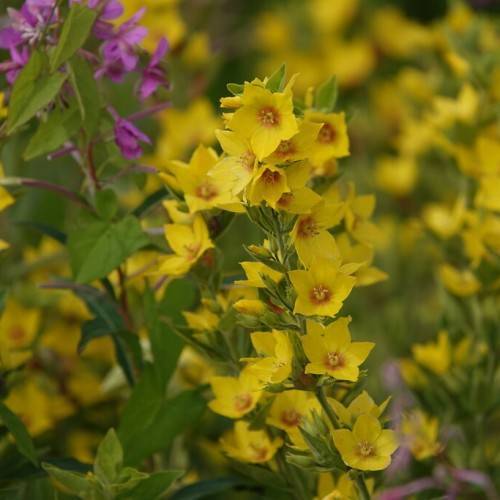
loosestrife
Lysimachia punctata
Also Known As - yellow loosestrifeCycle:
Herbaceous Perennial
Watering:
Frequent
Hardiness Zone:
4 - 8
Flowers:
Flowers
Sun:
Full sun,part shade
Soil:
Humus rich
Fruits:
Fruits In Autumn Ready In
Leaf:
Yes
Growth Rate:
High
Maintenance:
Moderate
Drought Tolerant:
Yes
Salt Tolerant:
Yes
Invasive:
Yes
Care Level:
Medium
watering
Loosestrife (Lysimachia punctata) is a moisture-loving plant that thrives best when its soil remains consistently moist. This plant should be watered about twice a week, allowing the top 3-4 inches of soil to dry out slightly between waterings. In periods of hot, dry weather, Loosestrife may need to be watered more often. Make sure to check the soil before watering to see if it is moist. If it is dry, water deeply at the base of the plant and allow the water to penetrate the soil.
sunlight
Loosestrife (Lysimachia punctata) needs a lot of direct sunlight. This species of plant grows best when it is exposed to 6 or more hours of direct sunlight each day. It is best to place the loosestrife in an area of your garden or landscape that gets plenty of direct sunlight during the day, especially during the morning and early afternoon hours when sunlight is most intense. If you live in a hot climate where the temperature is above 80 degrees Fahrenheit, it is important to provide some shade during the hottest part of the day, typically midday. This will ensure that the plant will not be stressed by the excessive heat. Proper sunlight exposure is essential to keep the plant healthy and ensure that it produces abundant blooms throughout the season.
pruning
Loosestrife (Lysimachia punctata) should be pruned during the springtime, once the last frost has passed and before new growth sprouts. The goal is to reduce the size of the plant and create a bushy, more compact shape. You can cut the stems back anywhere from 1/2 to 2/3 of their length. If your plant has become overgrown or unhealthy, you may decide to shorten some of the stems by up to the base. When removed stems, it's best to clean and sterilize your garden clippers or scissors with rubbing alcohol. Pruning loosestrife at the right time of year will help to promote fuller, healthier growth and encourage blooming.
